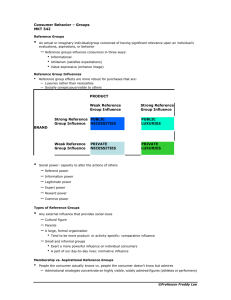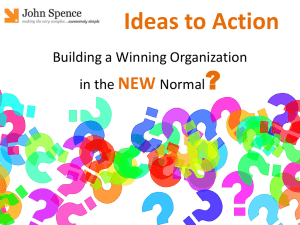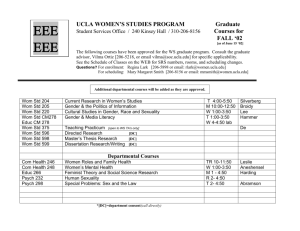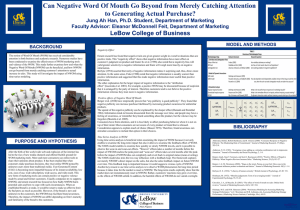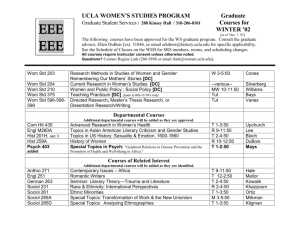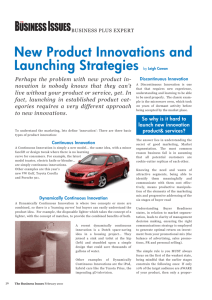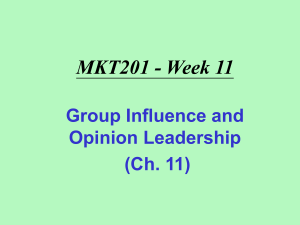Consumer Influence
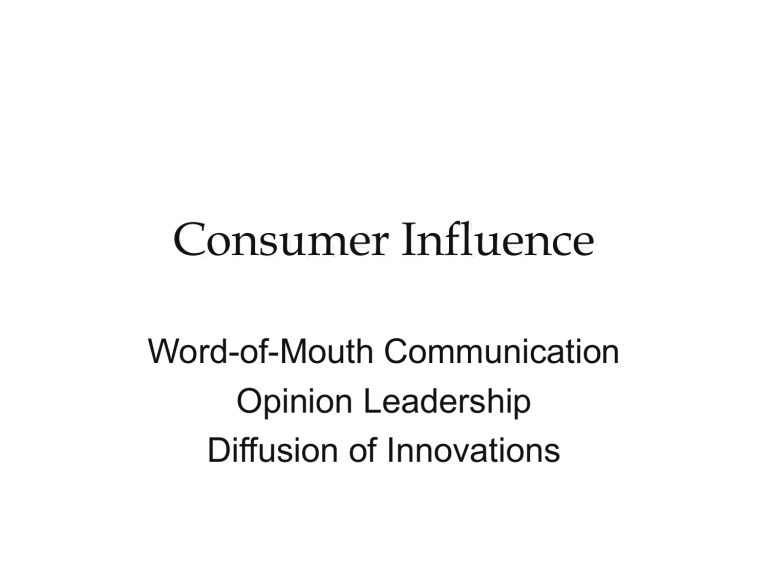
Consumer Influence
Word-of-Mouth Communication
Opinion Leadership
Diffusion of Innovations
Word-of-Mouth Communication
Discussions among consumers regarding marketplace issues.
A pattern of social communication.
Referral networks.
Spontaneous.
Negative WOM weighted more heavily by consumers than positive WOM.
Marketing Implications of WOM
Discourage negative WOM.
Refute rumors.
Stimulate additional direct sales through
WOM.
Simulate WOM in advertising.
Opinion Leadership
WOM communication involves consumers who seek and who give information.
How Does Opinion
Leadership Work?
Multistep Flow of Communication Theory
Mass
Media
Step 1a
Opinion
Leaders
Step 2
Step 3
Opinion
Receivers/
Seekers
Step 1b
Information
Receivers
Opinion Leaders are...
Technically competent--expert power.
Credible--unbiased opinions.
Socially active and interconnected in their communities.
Similar to other consumers--referent power.
Among the first to buy new products.
Highly involved with certain products.
Highly involved with messages about certain products.
Self-confident.
Differentiated from others and choose to act differently--public individuation.
Opinion Leaders share information because they need...
To reduce perceived risks associated with their purchases.
To talk about products with which they’re highly involved.
To share what they know.
Profile of Opinion Leaders
Generalized
Attributes Across
Product Categories
Category-Specific
Attributes
Innovativeness
Willingness to talk
Self-confidence
Gregariousness
Cognitive differentiation
Interest
Knowledge
Special-interest media exposure
Same age
Same social status
Social exposure
outside group
Methods of Measuring
Opinion Leadership
Self-designating method
Respondents’ perceptions
Most commonly used method
Subjective method
Sociometric method
Members of a social system identify opinion leaders and seekers for a product category.
Great degree of validity
Very costly and complex--better with self-contained group.
Key informant method
Carefully selected informants in a social system are asked to designate opinion leaders.
Relatively inexpensive and less time-consuming
Requires informants who are thoroughly familiar with the social system.
Objective method
Artificially places individuals in a position to act as opinion leaders and measures results of their efforts.
Controlled experiments
Marketing Implications
Design programs using WOM.
Simulate opinion leadership/WOM in advertising.
Design products with WOM appeal.
Use opinion leaders to trial new products.
Directly market to opinion leaders.
Diffusion of Innovations
A framework examining how consumers accept new products.
Two related processes:
Adoption
Diffusion
What is an Innovation?
An idea, process, or invention that is new or different.
Continuous
Innovation
Dynamically
Continuous
Innovation
Discontinuous
Innovation
Product-Oriented Definition of Innovation
Continuous Innovation
A modified or improved product.
Minor change in product benefits but no disruption of consumer behavior.
Weak category of innovation.
Dynamically Continuous
Innovation
Creation of new product or modification of an existing product.
Consumers have to alter their behaviors somewhat to use this innovation.
Moderately strong category of innovation.
Discontinuous Innovation
Usually technological new products offering major new benefits.
Consumers must discontinue past patterns of product usage to fit the new product into their lives.
Strong category of innovation.
Discontinuous
Innovation
Telephone
Dynamically Continuous
Innovations
Answering machines
Call forwarding
Call waiting
Caller ID
Banking by telephone
Call-prompting services
Continuous
Innovations
Hold button
Line-in-use indicator
Redial button
Auto dialing
Touch-tone phones
800 numbers
900 numbers
Adoption Process
5-step decision process:
Awareness
Interest
Evaluation
Trial
Adoption (rejection)
Adoption Process Model
Rejection
Discontinuation or rejection
Evaluation
Pre-existing problem or need
Awareness Interest Evaluation Trial
Adoption or rejection
Discontinuation
Adoption or
Rejection
Postadoption or postpurchase evaluation
Adopter Categories
Innovators
2.5% of population
Adventuresome
Open to change and the unfamiliar
Rely on their own standards or values
Seek variety; change brands frequently
Opinion leaders
Product-specific
Younger, higher incomes, higher education, higher occupational status
Early Adopters
13.5% of population
Interested in change and willing to take risks
More involved in social groups than innovators
Guided by group norms
Opinion leaders
Role models
Early Majority
34% of population
Less willing to take risks, but interested in new products
Adopt products just prior to the average adoption time
Seldom hold leadership positions
Want best possible alternative, so deliberate for some time before adopting
Late Majority
34% of population
Skeptical
Adopt new ideas just after the average adoption time
Innovations approached cautiously
Influenced more by advertising and other mass media information than by social groups
Laggards
16% of population
Traditional
Suspicious of anything new
Oriented to past
By the time they adopt, innovators may be adopting the next version of the product
Tend to be older, lower incomes
Diffusion Process
Research shows that diffusion tends to follow an S-shape
100
% of U.S.
households using a product
50
0
1990 1995
Year
2000 2005
What Influences Diffusion?
Social system
– Generally uncontrollable by marketers
Diffusion more rapid when social system has:
– Positive view of change
– Positive view of education and science
– Members who interact frequently with other social systems
Price
– Controllable by marketing
Penetration policy
Skimming policy
Product Characteristics
– Controllable by marketing
Relative advantage
Complexity
Observability
Compatibility
Trialability
Perceived risk
